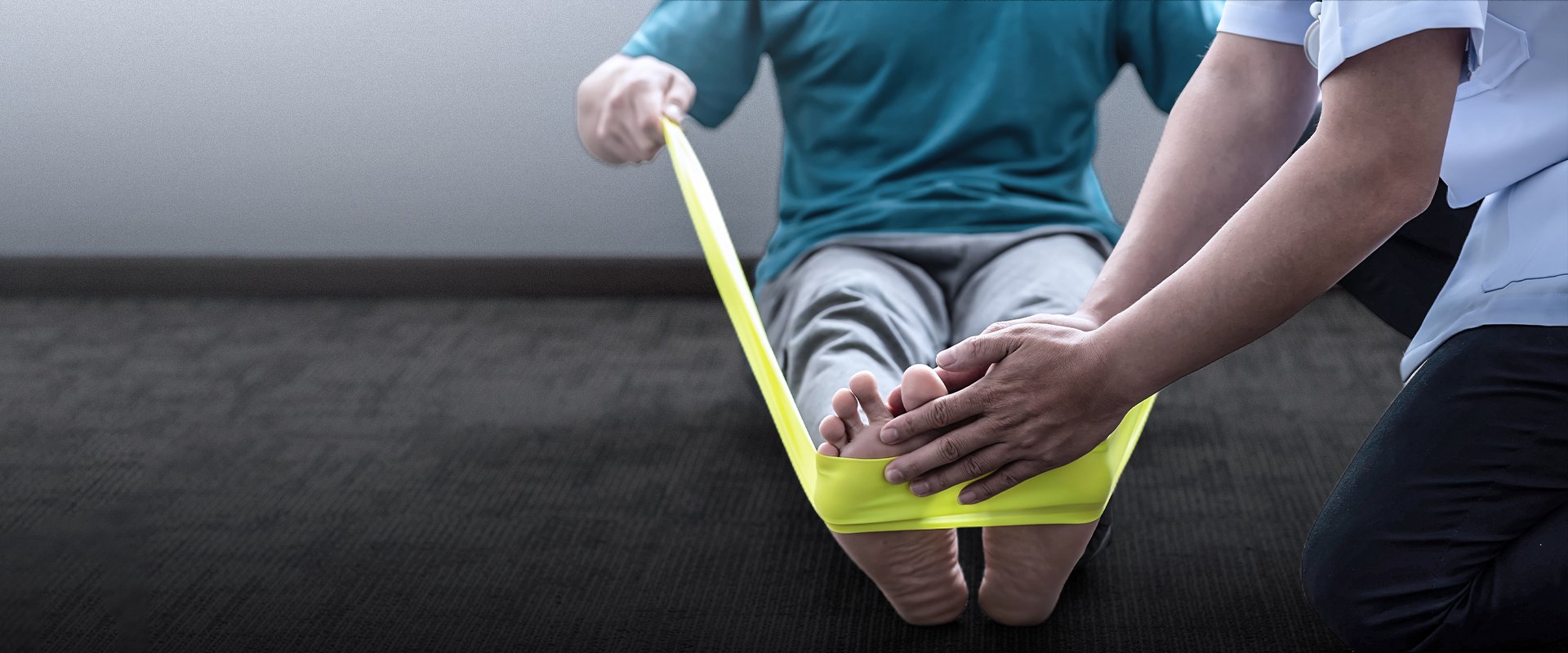
Physical Therapy for Torn ankle Ligament
AT EVOLVE
Physical Therapy for Ankle Ligament Tear
HOW CAN PHYSICAL THERAPY ADDRESS A LIGAMENT TEAR OF THE ANKLE?
A torn ligament in the ankle occurs when the ankle joint is moved beyond its normal range. Ligaments stretch between the bones in the ankle to stabilize them and limit joint movement. When a sudden and excessive motion of the ankle overstretches a ligament, a tear can occur. Physical therapy is often prescribed to help recover from an ankle ligament tear. Reducing symptoms like pain and swelling, restoring normal ankle flexibility, improving ankle strength and facilitating return to normal activity are goals of rehab for an ankle ligament tear.
WHAT DOES PHYSICAL THERAPY FOR A LIGAMENT TEAR LOOK LIKE?
When you begin rehab for a torn ligament in the ankle, my staff and I will apply the best, evidence-based techniques to address your symptoms. We will start with an initial evaluation to better understand your medical history and the pattern of symptoms you are experiencing. We will discuss your goals for physical therapy and perform an examination to assess your ankle and any other areas of the body that may be contributing to your symptoms. With all of this knowledge in hand, we will create a custom program that may consist of hands-on techniques performed by our therapists to your ankle and nearby areas combined with carefully prescribed movements and exercises performed by you in the clinic and at home to help the tear heal and the ankle to recover. In the case of post-surgical care for a torn ligament, your surgeon may provide us with a post-surgical rehab protocol that will guide us through your recovery.
HOW LONG WILL I NEED PHYSICAL THERAPY
Low and moderate grade tears may require 4-6 weeks of physical therapy while higher grade sprains may take several months. The activities you are looking to resume also play a role in the length of your plan of care. An athlete looking to return to running on rocky trails may need more rehab than an individual who only walks on even sidewalks as the demands on the ankle are different. Your physical therapist can give you an estimate of your rehab timeline during the initial evaluation and regular reassessment will also guide the plan. If you underwent surgery to repair a severely torn ligament, your post-surgical protocol will also dictate the length of your recovery time. Achieving long lasting results may take some time, but dedication to your home and clinic program will help you achieve these results more quickly.
Torn Ankle Ligament?
ANATOMY OF A TORN LIGAMENT?
Ligaments are bands of connective tissue that run from one bone to another across a joint. Ligaments allow for some motion in the joint but restrict excessive motion as they are not very elastic. There are 3 main sets of ligaments in the ankle:
- Deltoid ligaments: ligaments on the inside or medial side of the ankle
- Lateral ligaments: ligaments on the outside of the ankle
- Syndesmotic ligaments: ligaments that connect the lower leg bones, the tibia and fibula, just above the ankle
An injury to the ligaments of the ankle is also known as an ankle sprain.The most common ankle sprains are called inversion sprains which affect the lateral ligaments, eversion sprains which affect the deltoid ligaments and high ankle sprains which affect the syndesmotic ligaments. We grade these injuries based on how severely injured the ligament is damaged:
- Grade I (mild): microscopic damage has occurred to the ligament but only mild local tenderness and minimal bruising/swelling is noted without compromising joint stability. Typically takes 2-3 weeks to heal.
- Grade II (moderate): partial tear/rupture of the ligament. Obvious swelling and tenderness noted over the injured ligament but joint instability is either minimal or absent. May require up to 6 weeks to heal.
- Grade III (severe): complete rupture of the ligament with severe swelling and tenderness. This injury may be difficult to distinguish from a fracture initially. Instability of the joint is noticeable due to the severity of the rupture. Prolonged time to heal is frequent and may require surgery to repair.
With a more severe ligament tear it is important to rule out a possible ankle fracture as well. Signs and symptoms of a broken bone can overlap with those of a severe tear and include:
- Pain, tenderness and swelling over one of the ankle bones
- Redness and bruising
- Difficulty walking on or moving the ankle
End Injury Progression
Physical therapy for a torn ankle ligament has proven to slow and even stop pain issues, improve performance, and reverse injury progression in many cases.
Relieve Pain
The movements used in this technique can target your entire body helping you to manage discomfort and pain during the course of your physical therapy treatments.
Improve Range of Motion
Posture awareness is an important area to focus on due to the fact that certain positions may cause you further discomfort and pain.
Restore Mobility
You can regain mobility and flexibility by taking part in the stretches and exercises as prescribed by your physical therapist.
How Long Will Physical Therapy for Piriformis Syndrome Last?
PHYSICAL THERAPY INTERVENTIONS FOR PIRIFORMIS SYNDROME
PHYSICAL THERAPY FOR A LIGAMENT TEAR In the first week or so after an ankle ligament tear, your physical therapist will guide you on how to protect the recently injured and newly healing ligament. This may include the use of an assistive device like crutches. Immobilization with a splint is typically prescribed for one to several weeks after a grade II or III tear. While you may need to wear the splint while you are walking and active, your physical therapist will guide you through a process of restoring ankle motion during therapy. You want to minimize any movement that causes pain or places any stretch or strain across the injured site in the first phase of recovery but your physical therapist may passively move the ankle through small ranges of motion even from the start to prevent stiffness. As you move into subacute and chronic phases of healing and rehabilitation, your physical therapist will prescribe active motion and then resistance type exercises to facilitate continued healing and restore normal ankle strength and mobility. Exercises begin in a non weight bearing position and gradually progress to standing and weight bearing. Your therapist will monitor for any return of increased pain or swelling as you progress through your program. They may also utilize treatments such as soft tissue mobilization, taping, joint mobilization and modalities to manage pain and stiffness and promote ligament fiber alignment. Finally, in the later stages of healing your physical therapy treatment will focus on exercises and activities that prepare the injured ligament to withstand the stress and strain of everyday life and the sports and recreational activities you love to do. CALL TO SCHEDULE AN EVALUATION WITH EVOLVE PT While a ligament tear in the ankle can be frustrating, having the right care team to help you recover can make all the difference. The team of physical therapists at Evolve is here and ready to get you started on the road to recovery. Call to schedule an evaluation today.
Call to Schedule a Consultation! 1-718-258-3300Mill Basin (located in Harbor Fitness)
6161 Strickland Ave
Brooklyn, NY 11234
Monday: 7am-8pm
Tuesday: 7am-8pm
Wednesday: 8am-5pm
Thursday: 7am-8pm
Friday: 8am-1pm
Park Slope (located in Harbor Fitness)
550 5th Ave.
Brooklyn, NY 11215
Monday: 9am-8pm
Tuesday: 8am-6pm
Wednesday: 9am-8pm
Thursday: 8am-6pm
Friday: 8am-3pm
Gravesend
372 Avenue U
Brooklyn, NY 11223
Monday-Thursday: 8am-8pm
Friday: 8am-3pm
Kings Highway
945 Kings Highway
Brooklyn, NY 11223
Monday-Wed.: 12pm-8pm
Ready to take the next step to a healthier you?
Contact Us Today!
PHYSICAL THERAPY FOR TORN ANKLE LIGAMENT!
Need Physical Therapy for a Torn Ankle Ligament?
Let our caring and compassionate physical therapists help you with relieving pain while getting you back on your feet comfortably.
Call now to schedule your first PT consultation free of charge.
Call: 1-718-258-3300







